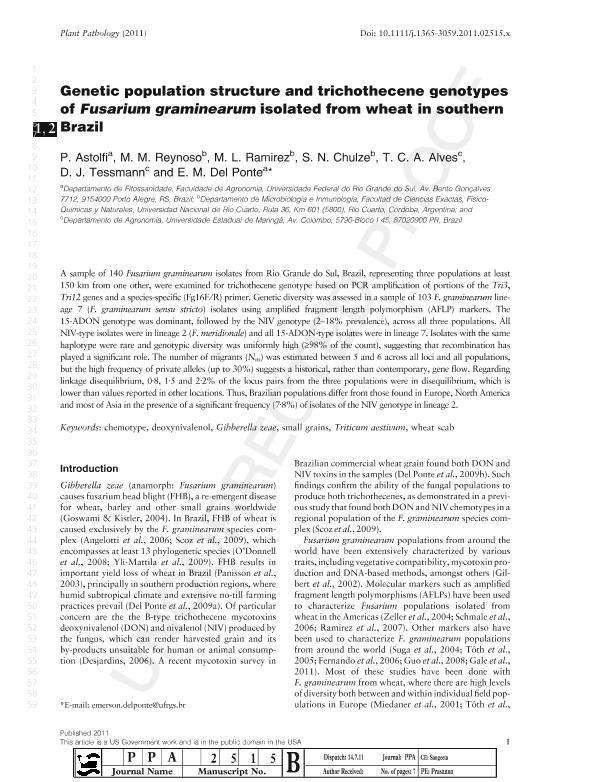Artículo
Genetic population structure and trichothecene genotypes of Fusarium graminearum isolated from wheat in southern Brazil
Astolfi, P.; Reynoso, Maria Marta ; Ramirez, Maria Laura
; Ramirez, Maria Laura ; Chulze, Sofia Noemi
; Chulze, Sofia Noemi ; Alves, T. C. A.; Tessmann, D. J.; Del Ponte, E. M.
; Alves, T. C. A.; Tessmann, D. J.; Del Ponte, E. M.
 ; Ramirez, Maria Laura
; Ramirez, Maria Laura ; Chulze, Sofia Noemi
; Chulze, Sofia Noemi ; Alves, T. C. A.; Tessmann, D. J.; Del Ponte, E. M.
; Alves, T. C. A.; Tessmann, D. J.; Del Ponte, E. M.
Fecha de publicación:
07/2012
Editorial:
Wiley Blackwell Publishing, Inc
Revista:
Plant Pathology
ISSN:
0032-0862
Idioma:
Inglés
Tipo de recurso:
Artículo publicado
Clasificación temática:
Resumen
A sample of 140 Fusarium graminearum isolates from Rio Grande do Sul, Brazil, representing three populations at least 150km from one another, were examined for trichothecene genotype based on PCR amplification of portions of the Tri3 and Tri12 genes and a species-specific (Fg16F/R) primer pair. Genetic diversity was assessed in a sample of 103 F. graminearum lineage 7 (F. graminearum sensu stricto) isolates using amplified fragment length polymorphism (AFLP) markers. The 15-ADON genotype was dominant, followed by the NIV genotype (2-18% prevalence), across all three populations. All NIV-type isolates were in lineage 2 (F. meridionale) and all 15-ADON-type isolates were in lineage 7. Isolates with the same haplotype were rare and genotypic diversity was uniformly high (≥98% of the count), suggesting that recombination has played a significant role. The number of migrants (N m) was estimated between 5 and 6 across all loci and all populations, but the high frequency of private alleles (up to 30%) suggests a historical, rather than contemporary, gene flow. Regarding linkage disequilibrium, 0·8, 1·5 and 2·2% of the locus pairs from the three populations were in disequilibrium, which is lower than values reported in other locations. Thus, Brazilian populations differ from those found in Europe, North America and most of Asia in the presence of a significant frequency (7·8%) of isolates of the NIV genotype in lineage 2. © 2011 The Authors. Plant Pathology © 2011 BSPP.
Archivos asociados
Licencia
Identificadores
Colecciones
Articulos(CCT - CORDOBA)
Articulos de CTRO.CIENTIFICO TECNOL.CONICET - CORDOBA
Articulos de CTRO.CIENTIFICO TECNOL.CONICET - CORDOBA
Citación
Astolfi, P.; Reynoso, Maria Marta; Ramirez, Maria Laura; Chulze, Sofia Noemi; Alves, T. C. A.; et al.; Genetic population structure and trichothecene genotypes of Fusarium graminearum isolated from wheat in southern Brazil; Wiley Blackwell Publishing, Inc; Plant Pathology; 61; 2; 7-2012; 289-295
Compartir
Altmétricas



